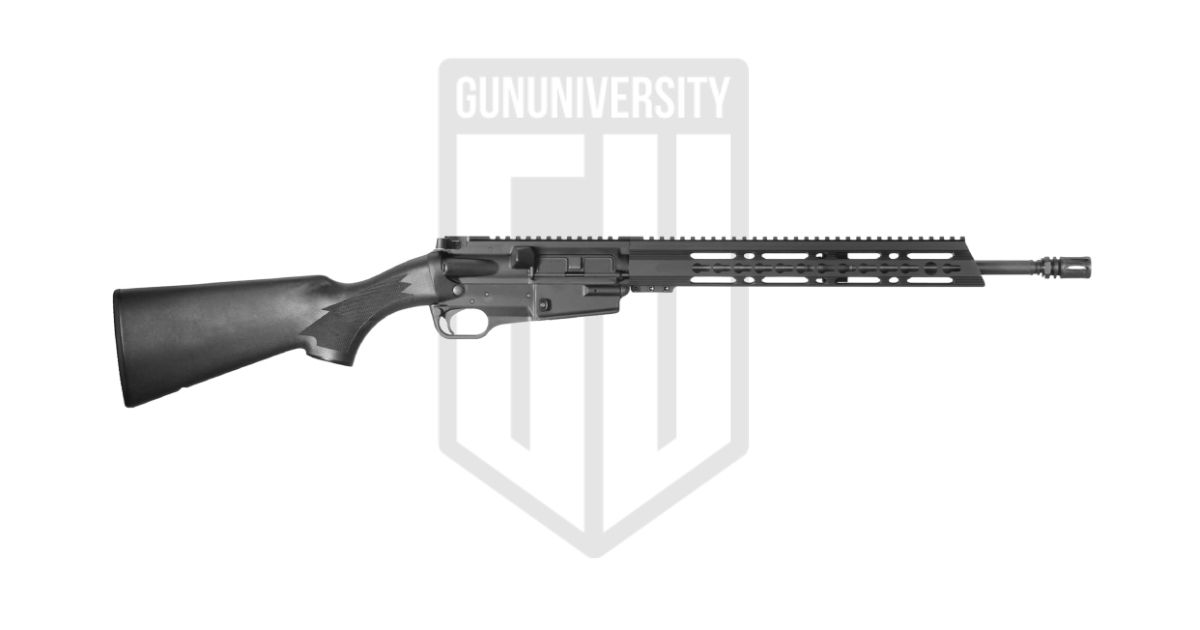AR-15 Pistol Brace Update: ATF Blocked
BREAKING NEWS (NOV 10 UPDATE): ATF Pistol Brace Ban is BLOCKED
With all the news about the ATF and AR pistol braces lately, we understand that you may have many question about what is going on and what to do about it.
The questions we’ve been seeing about this are:
- What is the ATF doing about pistol braces (and when)?
- How do I know if my AR pistol brace will be legal?
- What are AR pistol braces and why are they popular?
- What are my options after the new rule to have a pistol brace or SBR?
This article aims to answer all of those questions and more!
But first, a more important question: why should you listen to me when it comes to pistol braces? After all, it seems like every person with a blog and YouTube channel that knows which end of the gun is the noisy end has an opinion on this.

I care so much about this topic because I am an actual firearms attorney who fights against the ATF daily, a firearms industry expert (I used to manage federal government affairs for the NSSF and I was a voting board member of SAAMI), and I was invited by the U.S. Congress earlier this year to testify on this exact issue.
If you’re looking for the latest updates on the ATF and their Pistol Brace rules, we’ve got you covered. We’re keeping this article up to date with the latest ATF updates.
If you’re wondering what a pistol brace is and why they’re so popular, you’re in luck – we’re going to cover everything you need to know about pistol braces (sometimes called “pistol stabilizing braces”) further down in this article.
And, if you’re wondering what to do after ATF’s new rule takes effect, we’ve included a section called What to Do After ATF’s Pistol Brace Rule
Table of contents
ATF’s Pistol Brace Update
UPDATED NOV 10, 2023: The ATF’s Pistol Brace rule has been STOPPED!
A Federal Judge has just blocked the ATF from enforcing their pistol brace rule. This means that the rule still technically exists but while it is being legally challenged, the ATF is currently not allowed to enforce the rule against anyone. (previous legal victories against the pistol brace rule have only applied to certain people)
If you’re ready to race out and get an AR pistol brace, check out our Best Pistol Braces Review.
In this most recent legal update from Britto v. ATF, Judge Kacsmaryk agreed that the ATF over-stepped here, didn’t follow the appropriate rule-making procedures and effectively tried to make their own laws, and misrepresented the actual impact of this rule. He summarized his opinion with “…public safety concerns must be addressed in ways that are lawful. This Rule is not.”
If you are someone who registered your firearm as an SBR as part of the rule, it is now officially an SBR. I agree with Colion that it is likely that the ATF knew it was over-reaching and did it anyway to get a bunch of people to register their firearms as SBRs.
UPDATED AUG 1, 2023: Major legal victory! The 5th Circuit Court in Mock v. Garland has just determined that the ATF has exceeded its authority and effectively unlawfully made a law.
The court said that the Plaintiffs (those fighting the ATF) were likely to win their case against the ATF and therefore the ATF couldn’t enforce their new rule against them. This ONLY applies to the Plaintiffs and not the entire country.
UPDATED JAN 14, 2023: ATF has now published their final rule on pistol braces although it’s not official and the 120 day clock doesn’t start ticking until it appears in the federal register.
ATF’s latest attempt to ban pistol braces includes a scorecard system wherein pistol braces/pistol braved firearms are scored to determine whether they are a pistol with a brace or a short barreled rifle with a buttstock. Contrary to what many are claiming, this rule is NOT banning pistol braces – it is, however, considering many of them to be rifle stocks.
As we saw from ATF’s court filing, we expected this to drop this month.
The rule has not yet been published in the Federal Register (the first step to the rule making process) – when it is, the 120 day rule starts wherein current owners of pistol braced firearms that violated the new definition will have to have their firearms registered as NFA items.
We can gather some information on what ATF is going to do from the pistol brace information published by the Congressional Research Service and the National Shooting Sports Foundation is always a great resource for industry matters like this – you can read their official comment on the matter.
The ATF is going to waive the $200 tax normally associated with making an NFA firearm. This is good news if you think this is a good opportunity to make a few free SBRs. ;)
This scorecard system by the ATF in their new pistol brace rule is largely due to the fact that the ATF has struggled to define what is a buttstock or a pistol brace for a decade now.
Effectively, instead of outright banning pistol braces, which they have no authority to do yet that didn’t stop the DOJ from outright banning bump-stocks, they have compiled a list of features that can be evaluated to determine if the item in question is a brace or whether it is a buttstock.
This means they aren’t making the device itself illegal. Instead, they would be changing the classification of the device so that it can no longer be used to avoid the NFA requirements (tax and registration) of having a Short Barreled Rifle (SBR).
The implications of this rule are HUGE.
If the scorecard shows that your item is a buttstock, even though you bought it as a brace (and it was previously approved as a brace by the ATF), you would be a FELON if you possessed it with a barrel shorter than 16 inches and haven’t registered it as a Short Barrel Rifle (SBR).
As a note, being a felon would make you a prohibited person which means you could never lawfully posses firearms nor ammunition again.
ATF Pistol Brace Scorecard
The ATF scorecard for pistol braces from the Biden Administration was absurd.
The ATF proposed this scorecard as part of the proposed rule but they later abandoned the scorecard approach when they published the final rule: we are EXTREMELY THANKFUL that they abandoned this sheer stupidity for two reasons:
- Their change from this scorecard to a descriptive system is what allowed us to win in the most recent legal challenge – the ATF can’t propose one rule for public comment and then just change it at the last second.
- The amount of inconsistencies and ambiguities could easily take up their own article – here are some of the reasons it was such a bad idea (we’re keeping it here as a reminder to how inept the ATF actually is)
THIS SCORECARD SYSTEM NO LONGER APPLIES.
If the item in question received a score of 4 or higher from the scoresheet, then the ATF would consider the item to be a Short Barrel Rifle instead of a handgun with a pistol brace.
On the very first section, Accessory Design, your item can earn from 0 points (good) to 2 points (bad) based on unclear and arbitrary criteria.

If your item is not based on a known shoulder stock design, it earns 0 points. That might sound straight forward but what does “based on” mean? And “known” to whom?
If your item incorporates shoulder stock design features, it earns 1 point. Well, what is a design feature? If it’s black like a standard AR buttstock, is that a design feature? If it mounts onto a buffer tube, is that a design feature? Also, not “known” is missing.
If your item is based on a known shoulder stock design, it earns 2 points. It looks like “known” is back and we still don’t know to whom this must be “known.”
It also invites more questions like: does the item incorporate some shoulder stock design features because it was based on a known design? If so, how many points does it get? Or, does it have some stock features but it wasn’t based on a known design, does it get 0 or 1 point?
Trust me, it gets WAY worse.
For example, in one section of the form, you get 2 points if your item is a “fin-type design without an arm strap.” However, later in another section, if your item is a “fin-type lacking an arm strap” it gets 2 points. Is this just an inept ATF with a redundant typo OR do you get four points total for the same fin-type brace without a strap?
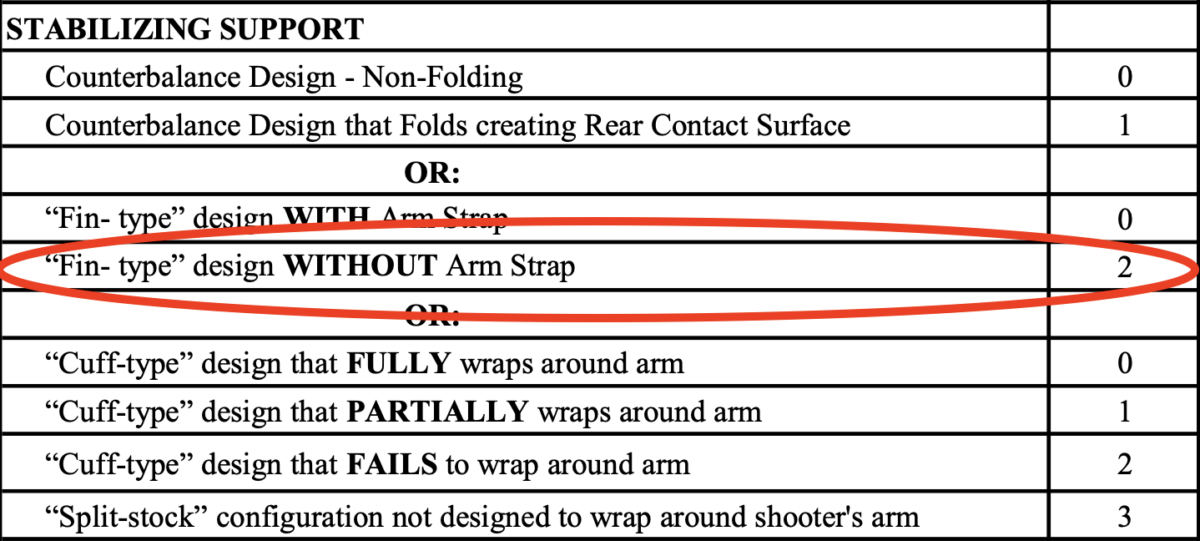

And, if you add red dot sights with magnifiers that don’t have good eye relief for one handed shooting on top of the firearm, your pistol brace on the back of the firearm earns points. How does that make sense?
Add iron sights? 1 point.
Have no sights at all? 1 point.
Have a bipod? 2 points.
Hand stop present? 2 points.
Foregrip? 4 points.
As you can see, the proposed ATF Form is not exactly easy to fill out and calculate.
What is a Pistol Brace?
A pistol brace is sold as a device that is added to the rear of a pistol in order to give support against the shooter’s firing arm. Because a pistol brace is not technically a rifle buttstock (the part of a rifle that supports the rifle against the shooter’s shoulder), it is a bit of a legal loophole that allows a firearm to have a shorter barrel than it would be otherwise legal to have.
Let me explain.
The federal definition of a rifle (18 USC 921(a)(7)) is a firearm that is designed and intended to be fired from the should and which has a rifled barrel. Therefore, if a firearm has a buttstock and the barrel contains the twisting grooves that impart spin on a bullet for stabilization (rifling), then that firearm is legally a rifle.
Another federal law (26 USC 5845(a)(3)) requires that rifles must have barrels at least 16 inches long and an overall length at least 26 inches long. If the barrel of a rifle is shorter than 16 inches, it is considered a “Short Barreled Rifle” (SBR) and it is subject to much stricter regulations and controls under the National Firearms Act (NFA) which include a $200 tax, ATF approval (many many months of waiting) prior to transfer, special engraving/marking requirements, and permission to cross state lines.
On an AR-15 style firearm, or “AR,” for example, the AR pistol brace is not different than any of the other AR parts (it is not a firearm by itself) other than it is the part that when attached to the buffer tube (the tube that sticks out the back of an AR-15 and which holds the buffer), it makes the firearm legally an AR pistol.
Pistol braces are not just for AR-15s – in fact, there are many firearms for which an arm brace can be purchased. For example, a conversion kit can be purchased to add a pistol brace to a CZ Scorpion EVO (instead of a shoulder stock).
If you’re already interested in getting yourself a pistol brace before they may be banned, we’ve compiled the best pistol braces for you.
Why are pistol stabilizing braces so popular?
Pistol braces are commonly known as a bit of a workaround to allow a firearm, such as an AR-15, to have a short barrel without needing to register the firearm as a “Short Barreled Rifle” (an NFA firearm).
Without using a pistol brace, if you wanted to install a barrel shorter than 16 inches on your AR-15 rifle, you needed to go through the NFA registration process. This process requires filling out an ATF Form 1, submitting it along with fingerprints, photos, and a check for $200 to the ATF, engraving your name and city/state on the firearm, waiting almost a year for approval fro the ATF before you could even have the parts in the same house, and then once you paid your tax and had permission to possess and install the shorter barrel, you were then subject to many other rules about where the firearm could be taken/used.
That was a pain in the ass (by design).
If you used a pistol stabilizing brace, however, you could simply take off the rifle’s buttstock, remove some of the lower parts if you took off the buffer tube for your particular AR pistol brace, and then install your pistol brace tube kit onto the lower receiver. After you’ve done this, the firearm is no longer a rifle so your short barrel can be installed without any extra work, money, or legal hassle.
If you had a firearm like an Sig Sauer MCX, you could just remove the buttstock from the rear picatinny rail and install the pistol brace as one complete assembly. However, other similar platforms like the Sig MCX Copperhead already have a pistol brace from the factory.
AR Pistol Brace Background
The ATF has had an issue with pistol braces ever since they came out and has tried various way to restrict or regulate their use.
SB Tactical was the pioneer of the pistol brace. They made the item with the advertised intent to help disable shooters handle AR-15 pistols. The ATF had no choice but to “approve” the items as they weren’t “designed and intended” to be fired from the shoulder.
It is important to note that an “AR pistol brace” is much like any other pistol brace legally. The difference is that an AR pistol brace is a device that is intended to fit onto an AR style firearm whereas other pistol braces are for other firearms.
Pistol braces became very popular and MANY Americans started making firearms into an AR 15 pistol instead of AR 15 Short Barreled Rifle. And, even though the items with technically a pistol stabilizing brace, they were used effectively as buttstocks when firing the guns.
The ATF’s first attempt to stop pistol braces was to claim that anyone who “shouldered” (meaning placed the pistol brace into their should for support when firing) a pistol brace has effectively “redesigned” the item into a buttstock and therefore had an illegal short barrel rifle. You can read the ATF’s latest rule making attempt from 2020 in their proposed rule making.
Using a brace on a pistol in your shoulder did not “redesign” the item. This was absurd. I personally argued with the ATF over this news at a SHOT Show meeting with them and I made the argument: “If I took a bolt action rifle, like a Remington 700 for example, and fired it with the buttstock against my forehead, have I now redesigned it into no longer being a rifle since I didn’t use my shoulder?”
Thankfully, the ATF finally saw the absurdity of their argument and backed off this stance. But, for a time, gun owners where prevented from “shouldering” a pistol brace.
Now, the ATF is back again trying to stop pistol braces…
Best AR-15 Pistol Braces
We’ve gathered and ranked our best pistol braces to help you decide which might be best for you.
Our list includes the main brands of braces like Maxim Defense, SB Tactical, KAK industry, Gear Head Works, Strike Industries, and Odin works.
Of course, we even included braces with (and without) the newly evil adjustable nylon strap (gasp)!
Here’s the editor’s choice pistol brace from our list followed by a quick pistol brace specs comparison.
Pistol Brace Specs
| Pistol Brace | Positions | Weight | Length |
|---|---|---|---|
| SBA3 | 5 position adjustable | 6.75 ounces | 9.5 inches |
| Gear Head Works Tailhook Mod 2 | 5 position adjustable | 7 ounces | 12.95 inches |
| SB Tactical PDW | 3 Position Adjustable | 18.14 ounces | 6.75 inches |
| KAK Shockwave Blade 2M | 12 Adjustable Positions | 4 ounces | 7.25 inches |
| Doublestar Corp Strongarm Pistol Brace | 1 Non-Adjustable | 4.8 Ounces | 1.9 inches |
| Strike Industries PDW Stabilizer | 2 Adjustable Positions | 19 ounces | 5.5 inches |
| Pistol Storage Devices | User Adjustable | 6 punches | NA |
Pistol Brace FAQ
Recent Posts
September 25, 2025
September 22, 2025
September 22, 2025
September 19, 2025

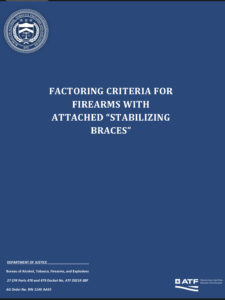
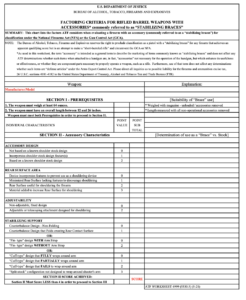
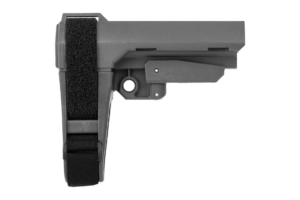
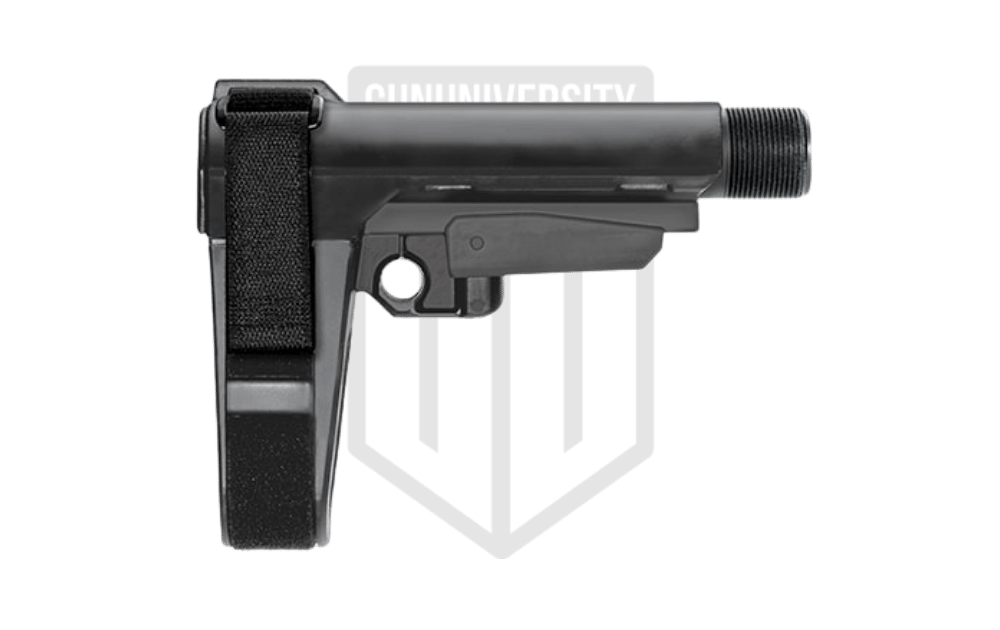
![7 Best Short-Barreled Shotguns in 2025 [Our Picks]](https://gununiversity.com/wp-content/uploads/2025/01/Short-Barrel-Shotgun.jpg)
